72 Hard-Hitting Facts About the 'Rocky' Movies
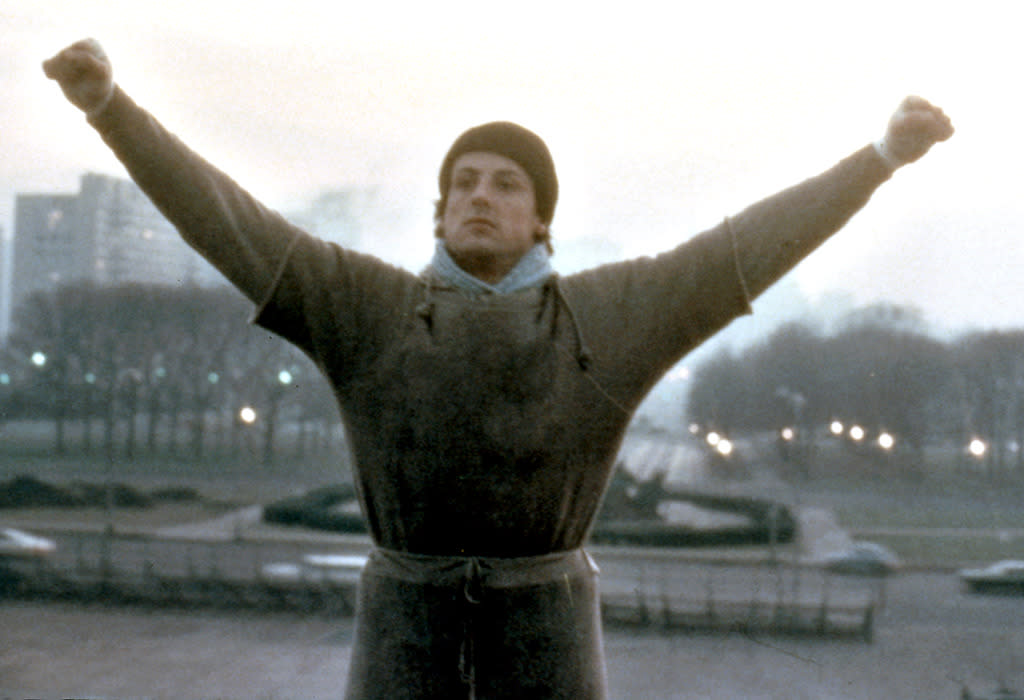
Sylvester Stallone in ‘Rocky’ (Everett)
By Adam K. Raymond
Sylvester Stallone has been careful to note that Creed “is not Rocky 7.” And that’s a huge relief. After six Rocky movies, there was little left to say about the Philly club fighter turned world champ. Creed, instead, turns the focus to Adonis Johnson Creed, played by Michael B. Jordan. The son of Apollo Creed is a struggling fighter who enlists his father’s old rival to help him in the ring.
To get you ready for the new drama that hits theaters on Thanksgiving Day, here are 72 knockout facts — the same as the number of steps in front of the Philadelphia Museum of Art — about the first six installments of the Rocky series. They’re culled from Blu-ray extras, commentary tracks and numerous media reports from the past 39 years. Now, as Mickey would say, “Don’t be a bum, and read that trivia!”
Watch the ‘Creed’ cast describe their perfect Philly cheesesteak:
Rocky (1976)
1. Stallone was inspired to write Rocky after watching Chuck Wepner’s 1975 title fight with Muhammad Ali, in which the journeyman heavyweight knocked down the champ for only the third time in Ali’s career. Wepner later sued Stallone for cashing in on his life story and they settled out of court.
2. Stallone’s first version of Rocky was much darker than the final draft. Rocky was an anti-hero, Mickey was a racist, and Rocky ended up throwing the final fight so he wouldn’t have to be a part of the vile world of boxing. Stallone says around 10 percent of the original script remained in the final version.
3. Producers Robert Chartoff and Irwin Winkler met with Stallone as a favor to his agent, and although they didn’t have any parts for him, they told Stallone to pass along anything he wrote. After rejecting on the script that eventually became the 1978 film Paradise Alley, the producers read Rocky and immediately optioned it. United Artists was interested, but wanted to cast a big-name actor even though the then little-known Stallone desperately wanted the role. Finally, the head of UA agreed to let Irwin and Chartoff cast Stallone after watching The Lords of Flatbush and mistakenly thinking Perry King was who they were casting.
4. Other than Burt Young (Paulie), none of the primary actors in Rocky were the first choice. Producers wanted Lee Strasberg for Mickey, but he wanted too much money. Burgess Meredith, a professional actor since the 1930s, stepped in. Boxer Ken Norton was lined up to play Apollo, but he dropped out at the last minute to go on the ABC show Superstars. Carl Weathers auditioned shortly after and got the part, even though he insulted Stallone’s acting during his read through and lied about having boxing experience.
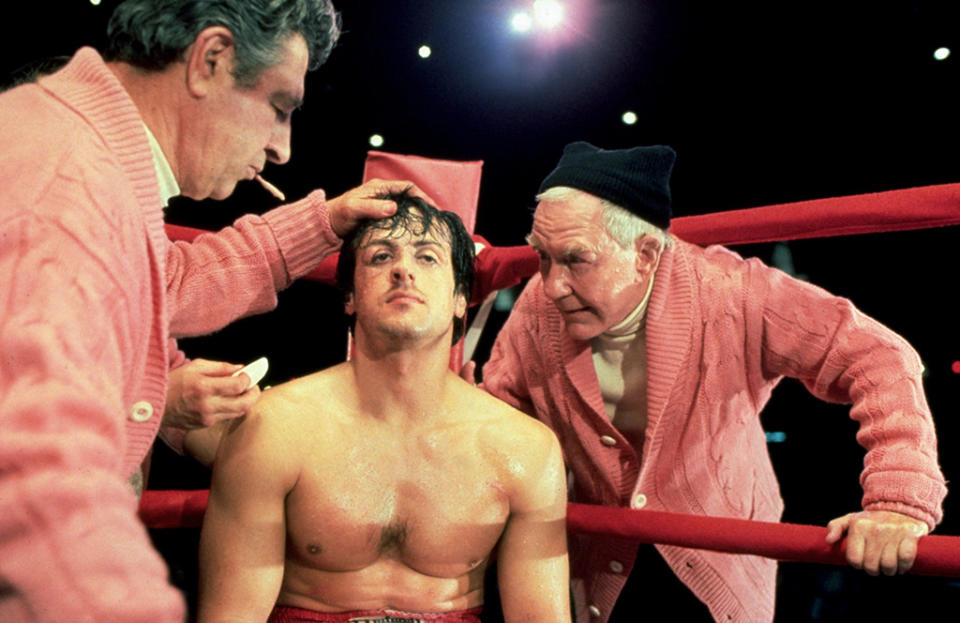
Stallone and Burgess Meredith in ‘Rocky’ (Everett)
5. Director John Avildsen and Stallone had to fight to shoot exteriors on location in Philadelphia. Producers wanted to shoot the entire in movie in L.A. to keep costs down, which was of particular interest to them because they were personally guaranteeing to cover any costs on the film over the studio’s allotted budget of $1 million.
6. Shooting in Philadelphia was done on a shoestring. There was no honeywagon, no catering, and no trailers. All exterior shots were lit exclusively with natural light, and pizza was the only on-set meal — for breakfast, lunch and dinner.
7. Among Stallone’s family members involved in the production were his brother, Frank Jr., who played one of the street singers, his father, Frank Sr., who rang the bell in the climactic fight, and his dog, Butkus, who played Rocky’s dog. Behind the scenes, Stallone’s then wife, Sasha, served as the production’s still photographer.
8. Several elevated trains can be seen rolling by the background in exterior shots. This was no accident, as a production assistant stood near the tracks with a walkie-talkie and would tell Avildsen when trains were coming so he could shout “action.”
9. Steadicam inventor Garrett Brown used his new device to film much of Rocky’s running throughout Philadelphia. In fact, Rocky’s iconic run up the stairs of the Philadelphia Art Museum was Brown’s idea. He filmed his wife running up those stairs as a proof of concept for the Steadicam and when Avildsen saw that footage he decided to use it in Rocky.
10. The Steadicam was also an essential part of shooting in the meat locker — allowing Brown to weave in and out of the beef sides — and the final fight between Rocky and Apollo. The device allowed Brown to circle the fighters in the ring and shoot over the shoulder of the one getting punched. Fake punches look a lot more realistic when you can’t see the point of contact, Brown says on the Blu-ray commentary.
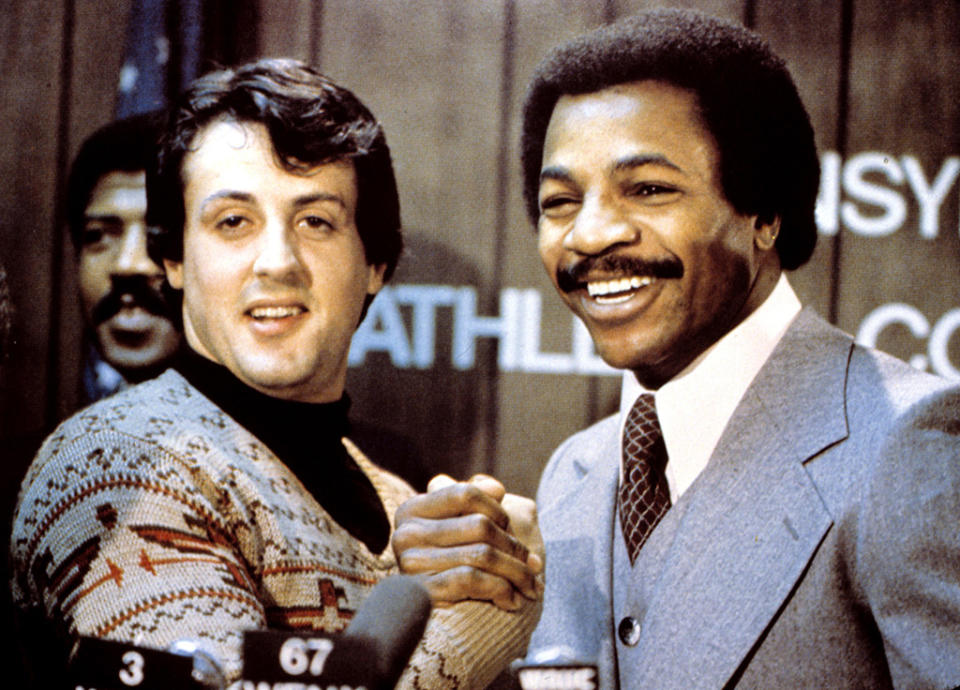
Stallone and Carl Weathers in ‘Rocky’ (Everett)
11. Stallone and Meredith wore prosthetic pieces throughout the film. To show the cuts around Rocky’s eyes, Stallone wore small pieces over his eyebrows, while Meredith had a fake cauliflower ear and a tube stuck up his nostril made his nose appear permanently disfigured.
12. Young was intent on making himself feel dirty and uncomfortable so he could channel Paulie’s discontent. He dabbed sweet vermouth, which he hates, on his neck and face. He wore layer upon layer of clothing so it would be harder to move and dipped his hands in turpentine so they would feel tight, mimicking arthritis.
13. Stallone encountered some opposition to his decision to have Rocky wear a pork pie hat. He was told he couldn’t wear it because Gene Hackman had worn a similar hat in The French Connection. Stallone was steadfast; he said the hat completed Rocky’s “suit of armor.”
14. Instead of an ice rink, Rocky and Adrian’s first date was originally set in a restaurant. Avildsen told Stallone to rewrite it so the characters would be moving around. Stallone revised it as an ice-skating scene that was supposed to include hundreds of extras. However, the budget didn’t allow for extras, ice skates, or stunt people. (Also, Stallone doesn’t ice skate.) “I don’t know why I wrote it,” he says in the commentary. The scene was salvaged when Avildsen suggested Rocky and Adrian take to the ice alone, and that Rocky jog along while she skated.
15. Stallone was able to easily down raw eggs before the training montage because it was something he’d done while living in a tiny New York apartment that didn’t have a stove.
16. The training montage began as a piece of music, around which Avildsen built the scene with footage shot largely with Brown’s Steadicam. It began as a 90-second piece and because there was more footage than music, composer Bill Conti kept having to add to the score. In the end, the montage was nearly three minutes long.
17. Among the real-life boxing figures in the movie are Jimmy Gambina — a trainer and the film’s technical advisor — who plays Mickey’s No. 2, Mike. Rocky’s cut man, Al Salvani, was a boxing trainer named Al Silvani. And of course, Joe Frazier appears in the ring before the final fight. Avildsen tried to get as many real-life champs as he could, but Smokin’ Joe was the only one to show.
Watch the original trailer:
18. Originally, the climatic fight wasn’t choreographed, but when Stallone and Weathers got together for their first rehearsal, confusion reigned. Avildsen asked Stallone to map out each punch of the fight, and the next day he had more than a dozen pages of lefts and rights written out. The actors rehearsed that, like a dance, for weeks, referring at times to 8mm footage of their rehearsals to see what needed to change.
19. Avildsen fought to get the producers to spring for the giant posters of Rocky and Apollo hanging in the arena during the fight. The mistake with Rocky’s shorts (they were red with a white stripe in the poster, but Rocky was planning to wear white shorts with a red stripe) was unintentional. Ultimately, Avildsen was happy about the mistake because it allowed for an exchange between Rocky and promoter Miles Jergens in which Jergens says the mistake “doesn’t really matter, does it?” Once again, the audience was reminded just how little everyone thought of Rocky.
20. There weren’t nearly enough extras during the final fight to fill the 8,000-seat arena, which is why it’s so dark during the fight. The shots that show a full stadium are stock shots of Madison Square Garden.
21. In the original ending, Apollo is carried out of the ring in celebration and Rocky and Adrian retreat to the bowels of the stadium. The shot of them holding hands and walking into the darkness is featured on the movie’s poster.

Stallone and Weathers in ‘Rocky II’ (Everett)
Rocky II (1979)
22. While on the publicity tour for Rocky, Stallone told the New York Times his plans for a trilogy that never happened. In the sequel, the paper said, “Rocky would go to night school and enter politics and eventually become mayor of Philadelphia. And in Part III, he would be framed by the political machine because he was too honest, impeached and wind up back in the ring at 37, broken down but happy.”
23. Stallone’s own discomfort in front of the camera after the success of Rocky inspired him to write the scene of Rocky fumbling through a commercial shoot.
24. Carl Weathers says in this making-of featurette that he never worked as hard as a professional football player as he worked to prepare himself physically for the fight in Rocky II. “The physical training for this film was the hardest thing I’ve ever done in my life.”
25. Chuck Wepner, the real fighter who inspired Stallone to write Rocky, read for the part of a sparring partner named Chink Weber. Wepner did so poorly that he didn’t get the part and the character was cut from the movie.
26. Former lightweight champion Roberto Durán has a cameo in the movie as one of Rocky’s sparring partners.
27. While training for the movie, Stallone tore his right pec and had to get 160 stitches under his right arm.
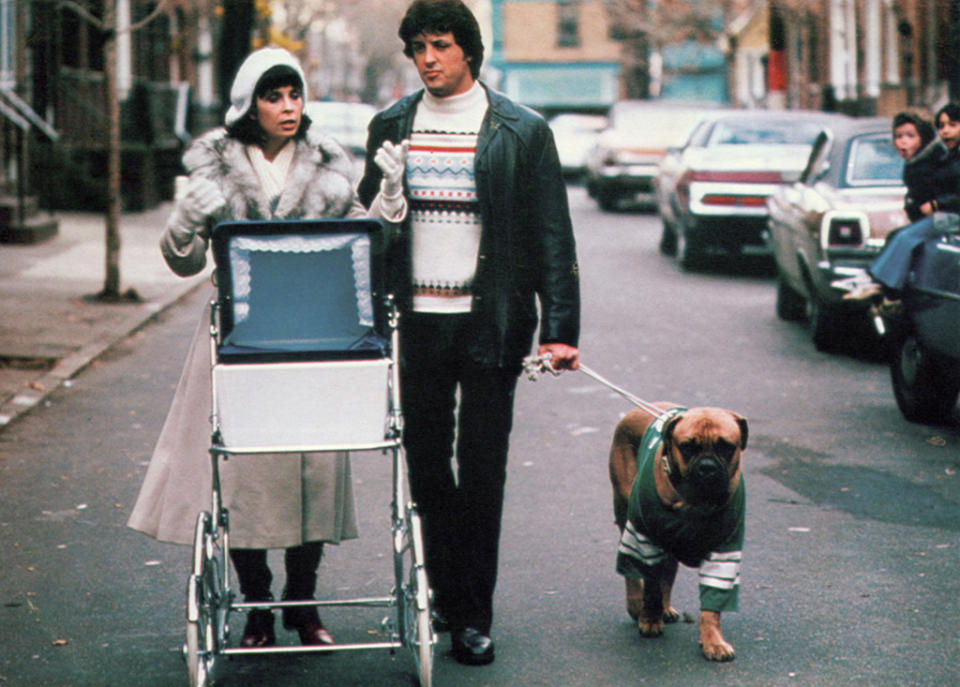
Talia Shire and Stallone in ‘Rocky II’ (Everett)
28. A writer for Philadelphia magazine calculated that Rocky’s run in the movie’s montage would have been 30 miles long as he bounced around the city in a seemingly illogical way. That have been a ridiculously long run for Rocky, much less the 800 school children who followed him through the streets during the montage.
29. The film reveals that Adrian’s last name is Pennino, the same as Talia Shire’s mother.
30. After filming, Stallone said he was “real messed-up inside.” Weathers pummeled him, he said, with eight times as many punches as he did in the original. “It was the most grueling thing I’ve ever been through,” he told film critic Roger Ebert.
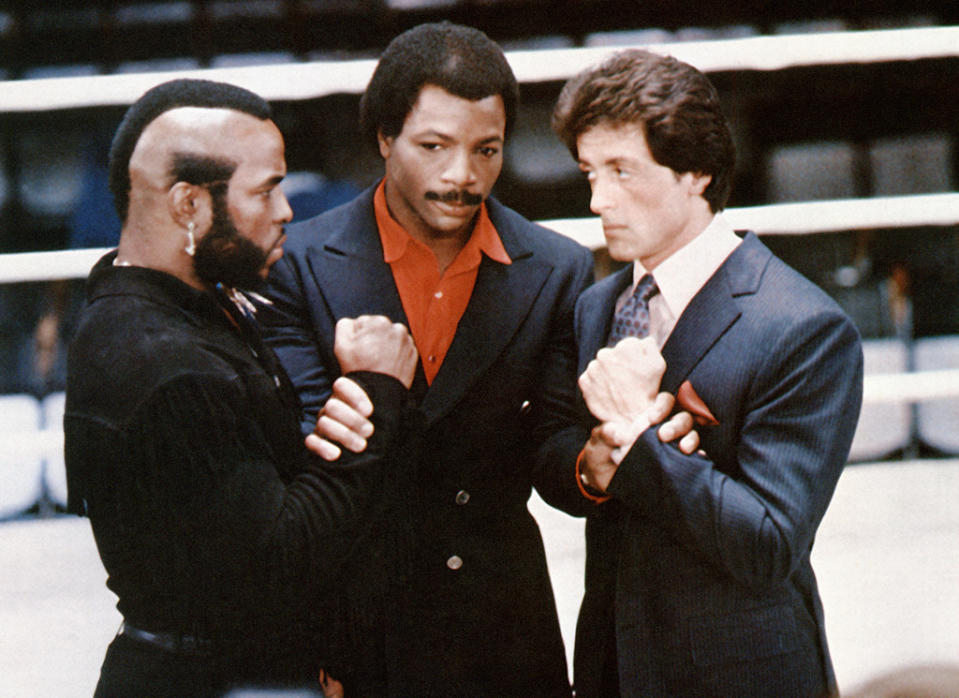
Mr. T, Weathers, and Stallone in ‘Rocky III’ (Everett)
Rocky III (1982)
31. In 1979, Stallone also told Ebert that the completion of the Rocky trilogy, which is how he imagined it then, would have the boxer traveling to Rome to fight in the Roman Colosseum. “I’m seriously gonna try to work in an audience with the pope into the film,” he said. A year later, he was still wrestling with how Rocky III would end, and told Ebert, “If I have the nerve, if I have real nerve, Rocky should die at the end of the third film.”
32. Producer Robert Chartoff says in a Blu-ray featurette that Clubber Lang was never supposed to have a mohawk or outrageous sideburns. Those were all from star Mr. T, a former bodyguard for Muhammad Ali and Sugar Ray Leonard, among others.
33. Stallone got his body-fat percentage down to an astounding 2.8 percent for the movie. He did this by giving his life over to working out and subsisting only on 10 egg whites, a piece of toast and a piece of fruit each day.
34. Stallone wanted to use Queen’s “Another One Bites the Dust” for the training montage, but couldn’t get the rights. So he asked the band Survivor to write a song for the movie, and they came up with “Eye of the Tiger,” which went on to win a Grammy. Joe Esposito’s song “You’re the Best,” was also written for the movie, but Stallone rejected it, leaving it available for The Karate Kid.
Watch Stallone recast his most famous roles:
35. Famed painter LeRoy Neiman, whose most famous work is a portrait of Rocky, began a series of cameos as a ring announcer with Rocky III. He’d go on to appear in the next two movies in the series.
36. Stallone commissioned a bronze statue of Rocky before production of the film began and donated it to the city after filming was complete. In 2006, when plans were made to move it from the Philadelphia’s Spectrum to the art museum, opposition arose from some who argued that it wasn’t art, but rather a “movie prop” that didn’t belong at the museum. Eventually it was placed at the bottom of the now famous Rocky Stairs.
37. Johnny Carson was so impressed by Hulk Hogan’s performance as Thunderlips that he booked the then unknown wrestler on The Tonight Show. It’s a good thing, too, because Vince McMahon fired the young wrestler from the WWF for appearing in the movie when he was supposed to be wrestling.
38. The montage at the beginning of the film includes footage of Stallone on a 1978 episode of The Muppet Show. Jim Henson helpfully recorded a new intro with Kermit announcing the guest as Rocky Balboa so it could be used in the film.
39. The climatic fight between Rocky and Clubber Lang is the only one in the series that doesn’t go a full 15 rounds. It’s over in three.
40. Stallone’s brother, Frank, continues his cameo streak in Rocky III, this time playing one of the mopes Rocky beats down in the movie’s opening montage.
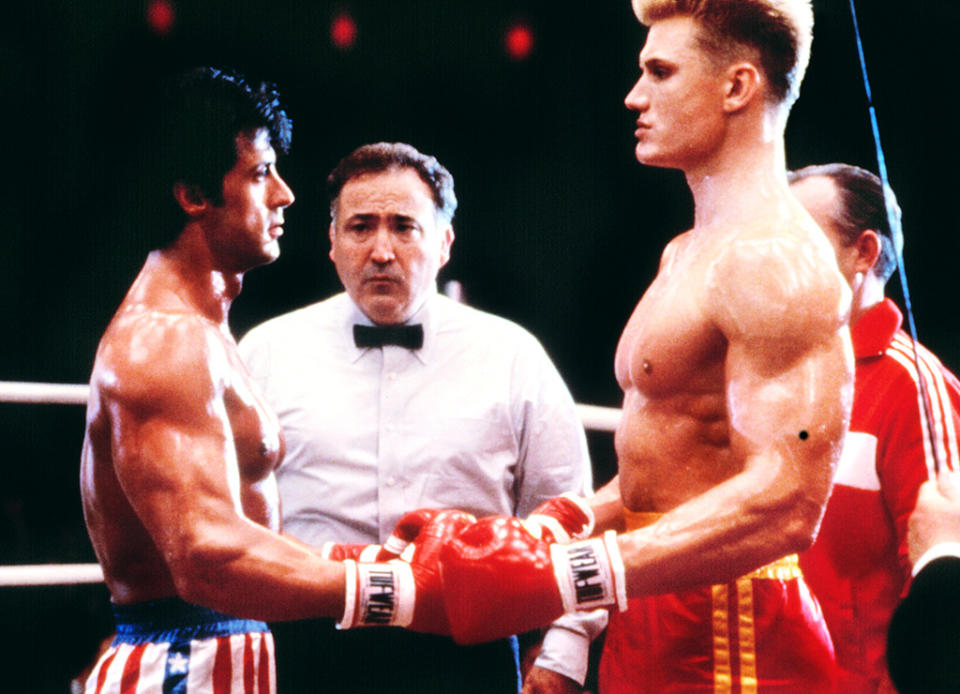
Stallone and Dolph Lundgren in ‘Rocky IV’ (Everett)
Rocky IV (1985)
41. In a 1979 interview with Roger Ebert, Stallone said, “There’ll never be a Rocky IV. You gotta call a halt.” But in 1982, while doing press for Rocky III, he admitted that a fourth film wasn’t out of the question. “The only way I would make it is if Rocky has to step outside himself and enter the international community,” he said. Stallone would later say that the fight with Ivan Drago was, at least in part, based on a fight between Joe Louis and German heavyweight turned Nazi puppet, Max Schmeling.
Watch the trailer:
42. When he auditioned for the role of Ivan Drago, Dolph Lundgren was a male model with a degree in chemical engineering. At the initial cattle call, he was dismissed for being too tall. Undeterred, Lundgren sent photos of himself in boxing gear to Stallone, which eventually led to a meeting with the star.
43. Lundgren had to gain about 20 pounds for the role, so he followed a training regimen that required bodybuilding six days a week.
44. Stallone worked with champion bodybuilder Franco Columbo to achieve a more muscular look than he had in the previous movie. Ultimately, he added 10 pounds and several inches to his arms and chest.
45. Chartoff saw Drago as the “indomitable enemy,” representing everything we fear about the Soviet Union. “If there had ever been conflict, this is what we would have had to face,” he says. Lundgren, meanwhile, said he felt sympathy for Drago, who was a pawn in the machinations of an evil empire.
46. In a bid for authenticity, Stallone asked Lundgren to really try to knock him out on their first attempt at shooting the fight scene. After Lundgren caught Stallone in the chest with a particularly ferocious shot, Stallone called it off. Later that night, he was forced to go to the hospital and remained in intensive care for five days. “He hit my heart so hard that it banged against my ribs and started to swell, and that usually happens in car accidents,” he later said.
47. Lundgren also roughed up Carl Weathers during their fight, at one point picking him up and throwing him into the corner. As Stallone remembers it years later, Weathers jumped out of the ring and threatened to quit because of the Swede.
48. Paulie’s robot was built by a company called International Robotics to help work with autistic children. Stallone’s son is autistic, and after inviting the robot into his home, Stallone wrote it into his movie. The robot’s voice, both male and female versions, is provided by International Robotics founder Robert Doornick.
49. When Rocky goes to the frozen Russian tundra to prepare for his fight against Drago, he’s actually in Wyoming. The final fight, set in a large Russian city, was filmed at the Agrodome Arena in Vancouver.
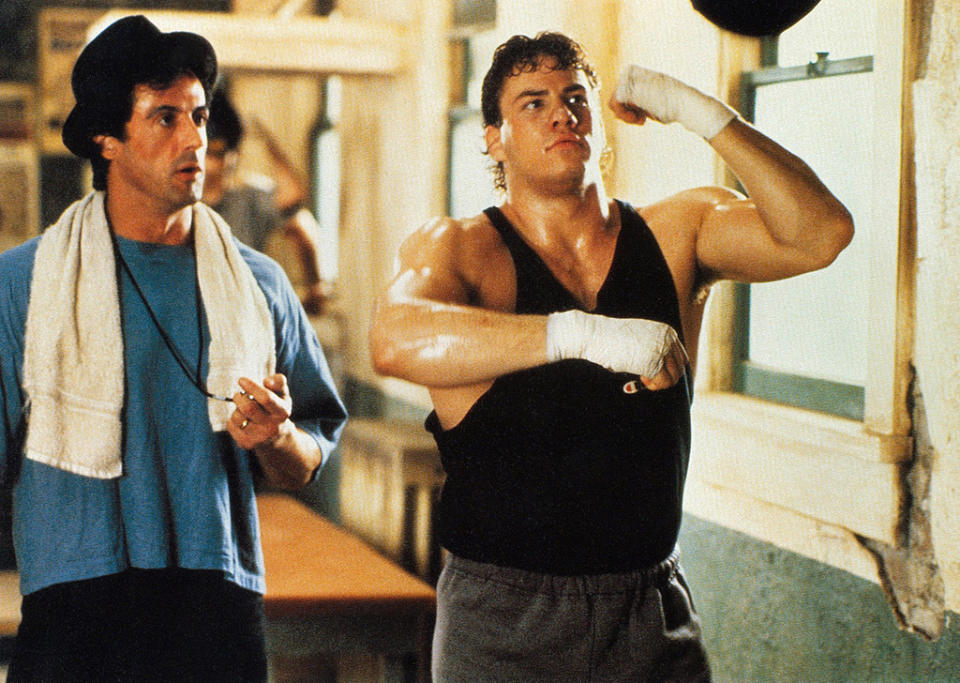
Stallone and Tommy Morrison in ‘Rocky V’ (Everett)
Rocky V (1990)
50. After four blockbuster Rocky films, Stallone returned with a fifth that showed a sad, desperate Rocky who didn’t have the triumphant moments fans were used to. This, Stallone said in a 2010 interview, is why the movie flopped. “It was a mistake because the audience didn’t want to see the downside of the character. They wanted him to remain on top,” he told the Sun.
51. Real-life fighter Tommy Morrison (who played Tommy Gunn) can thank Frank Stallone Jr. for his star turn in the fifth installment of Rocky. Frank saw Morrison fighting on TV one night and, knowing a villain was needed for Rocky V, told his brother to look into the young heavyweight.
52. Stallone’s real-life son Sage plays Rocky’s son in the movie. The raw emotion he showed in the movie was easy to muster given the similarities between the film and his life. “When I was screaming: ‘You never spent time with me! You never spent time with my mother!’ that was true. I was looking into my father’s face and really saying that,” he told People. (Sage passed away in 2012.)
53. Chartoff and Winkler returned once again to produce Rocky V, 14 years after the original. In that time, Winkler observed quite a change in his star. The difference between Sly in Rocky, as a starving actor, and Sly in Rocky V, when he “was like the Prince of Liechtenstein,” was just enormous, he recalls on the Blu-ray commentary. For the original, Stallone was “there every minute and very attentive and it showed” he added.
54. Throughout much of shooting, the plan was to kill off Rocky in the climactic street fight at the end of the movie. Stallone reportedly cried when he wrote the scene, but ultimately decided to change it. Some reports say producers forced the change and others say it was Stallone who decided that dying in a street fight wouldn’t be a fitting end for Rocky.
55. Like Morrison, Michael Anthony Williams (who played Union Cane) was a real boxer. There were rumors that Williams and Morrison were to have a real fight after filming wrapped on Rocky V, but the two boxers never met in anything but the fictional match.
56. The fight between Gunn and Cane was filmed in the Philadelphia Civic Center and called for 10,000 extras. Admission coupons were printed in the newspaper and given out by radio stations.
57. Jodi Letizia, who played the foul-mouthed young Marie in Rocky, was supposed to reprise her character in Rocky V and show that, as predicted, she ended up living a life on the streets. Her scenes were cut, though she does make a brief appearance during the street fight. When the character returns in Rocky Balboa, she’s played by another actress.
58. The speech that Mickey gives Rocky in the flashback scene was taken, almost verbatim, from a monologue delivered by legendary trainer Cus D’Amato about Mike Tyson.
59. Pro wrestling legend Terry Funk helped coordinate stunts for the movie. Funk had previously worked with Stallone on Paradise Alley and Rambo III.
60. In a 2010 interview, Stallone admitted Rocky V “stank.” He went on, “It was terrible. I couldn’t let that be the last word on that character. He could just speak what was in his heart. When I say it, you won’t believe it. But when Rocky says it, you know it’s the truth.”
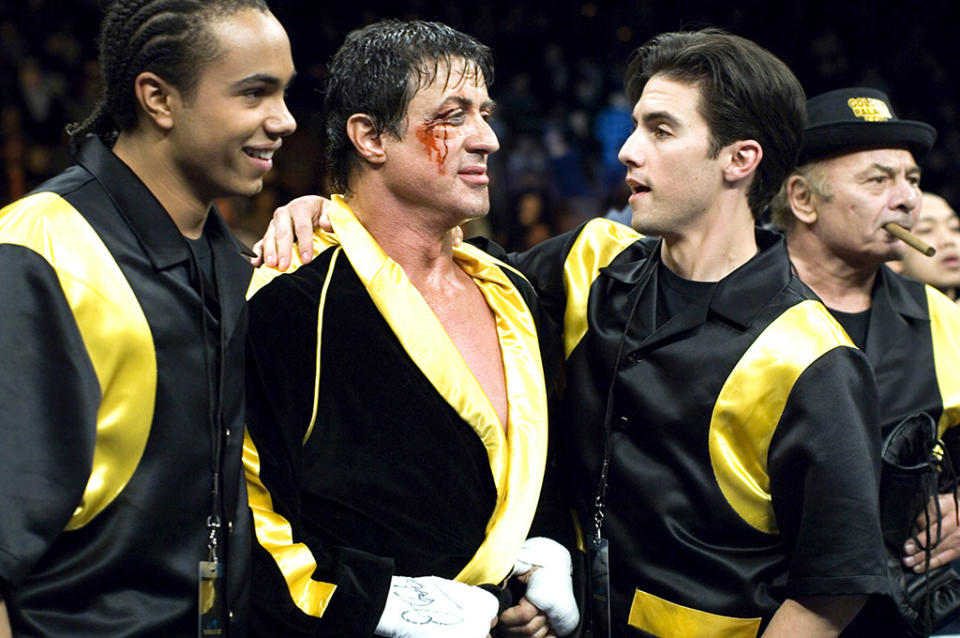
James Francis Kelly III, Stallone, Milo Ventimiglia, and Burt Young in ‘Rocky Balboa’ (Everett)
Rocky Balboa (2006)
61. Stallone was motivated to make one more Rocky movie because of the disappointment that was Rocky V. “I felt obligated to try and end the series the way it should have ended,” he told EW. He first got the notion to add a coda to the series in 1996, but it took him another decade to find a studio willing to make the movie.
62. Stallone considered calling the film, Puncher’s Chance. “I’m glad I didn’t,” he says on a Blu-ray commentary.
63. In the original script, Adrian was alive but “it just didn’t have the same dramatic punch,” Stallone told USA Today. “I thought, ‘What if she’s gone?’ That would cut Rocky’s heart out and drop him down to ground zero.”
64. Stallone wanted the boxer Roy Jones Jr. to play Mason “The Line” Dixon, but after making 32 phone calls and not having a single one returned, Stallone moved on. He ended up casting Antonio Tarver, a former light-heavyweight champion.
65. Among Stallone’s inspirations for Rocky Balboa’s storyline was George Foreman’s 1994 fight with Michael Moorer, in which the 45-year-old Foreman won by knockout and became the oldest-ever heavyweight champion. Another inspiration was the fictional fight between Muhammad Ali and Rocky Marciano in 1969.
Watch the ‘Rocky Balboa’ trailer:
66. The impassioned speech Rocky gives to the licensing board reflects Stallone’s efforts getting this movie made, he says. Stallone felt that he, like Rocky, was considered a has-been in the eyes of much of the public.
67. In an alternate ending, Rocky wins the fight in a split decision. He’s carried out of the ring and showered in cheers.
68. The training montage was an intentional departure from those of the past. Rather than working on quickness and stamina, Rocky emphasizes power. And to do that, Stallone shot the scene in a powerlifting gym, which he only had access to for a single day. After 17 hours of shooting, “walking the next day was out of the question,” he says.
69. The pre-fight press conference was held on the set used for a real pre-fight press conference before a bout between Bernard Hopkins and Jermaine Taylor. Stallone says they just tried to duplicate what they saw.
70. The fight also took place in the same venue as the Hopkins fight and made use of the fans in attendance. Stallone wanted the fight to look like a real televised bout. HBO’s branding and boxing announcers lend some authenticity, as does the switch to high-def cameras that make the fight and its lead-up look less cinematic and more like they’re appearing on TV.
71. The fight between Rocky and Dixon wasn’t choreographed. Stallone wanted this fight to look as real as possible. Planning each punch, as he’d done before, often led to unrealistic looking fights, Stallone said on Blu-ray commentary. So he and Tarver just got in the ring and started trading blows, “hoping to not get knocked out cold.” While both men avoided serious injury, they still took their lumps. Stallone broke a bone in his foot, and Tarver broke a bone in his hand.
72. For the first time in the series, the sound effects for punches are actual punches. Stallone says in the previous films, sound editors used recordings of things such as shotgun blasts, bottles breaking, chains rattling, and a baseball bat hitting wet leather to get the desired effects.

